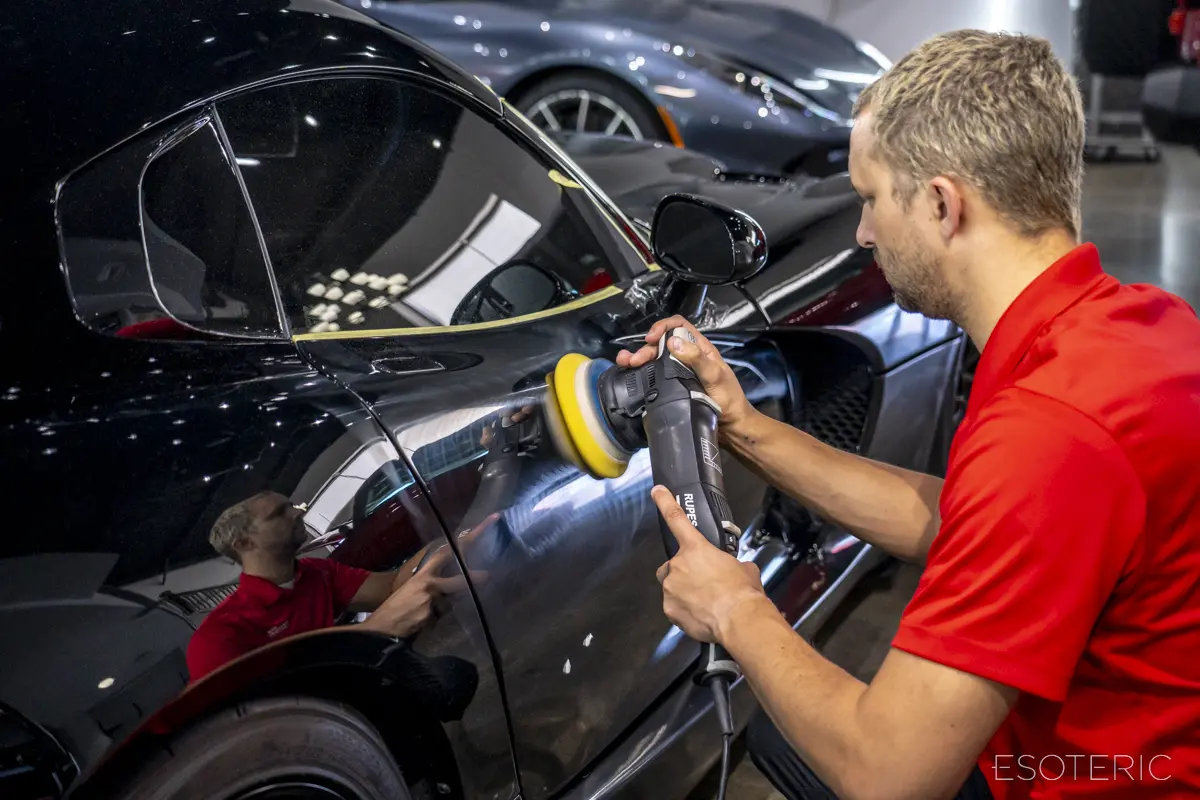Car polishing is an essential part of vehicle maintenance that helps maintain the shine and longevity of your car’s paint. However, knowing how often to polish your car can be confusing. In this blog, we will answer this frequently asked question and provide guidance on when and how to use car polish on your vehicle.
Why is Car Polishing Important?
Car polishing helps remove minor scratches, oxidation, and contaminants from your car’s paint. It also enhances the shine and overall appearance of your vehicle, giving it a like-new look.
A car’s paintwork is subject to numerous environmental stressors such as UV rays, acid rain, and road grime. Over time, these elements can degrade the paint, causing it to lose its luster and develop imperfections. Polishing addresses this by removing a thin layer of paint and surface contaminants, revealing a fresh, glossy layer beneath.
Regular polishing not only keeps your car looking great but also plays a key role in maintaining its resale value. A well-polished car is more likely to attract potential buyers who are willing to pay a premium for a vehicle that appears well-maintained. In essence, car polishing is akin to rejuvenating your car’s exterior, much like a cosmetic treatment for the vehicle.
Moreover, polishing lays the groundwork for other protective treatments. For instance, a polished surface is more receptive to wax or ceramic coatings, improving their adhesion and effectiveness. Thus, polishing acts as a preparatory step for further enhancing the long-term protection of your car’s paint.
Factors That Determine Polishing Frequency
The frequency of car polishing depends on multiple factors including how often you drive your car, the environments you drive in, and the type of car polish you use. Generally, if you frequently drive in harsh conditions, you will need to polish more often.
Environmental conditions play a crucial role in determining polishing frequency. Vehicles exposed to extreme sunlight, coastal areas with salty air, or regions with heavy industrial pollution will require more frequent attention. Such harsh conditions can accelerate the degradation of the paint, making regular polishing necessary to counteract these effects.
Another critical factor is the type of polish used. Wax-based polishes typically require more frequent application due to their shorter lifespan, often needing a touch-up every three to four months. In contrast, ceramic and synthetic polishes offer longer-lasting protection, sometimes extending the interval between applications to six months or even a year.
Your driving habits also impact how often you should use car polish. Frequent driving in areas with lots of debris, gravel, or construction zones can lead to more chips and scratches on your car’s paint. In such cases, you might find it necessary to polish your vehicle more regularly to maintain its aesthetic appeal.
Lastly, personal preference and the desired appearance of your car can dictate polishing frequency. Some car enthusiasts prefer a consistently high-gloss finish and might choose to polish their vehicles more often. Others might prioritize functionality and opt for less frequent polishing as long as the protective coatings remain intact.
Signs Your Car Needs Polishing
Look for signs such as a dull finish, swirl marks, minor scratches, and water spots. These are indicators that it might be time to apply car polish to restore the shine and protect the paintwork.
A fading or cloudy appearance in your car’s paint is a common sign that polishing is needed. Over time, the paint can oxidize and lose its clarity, especially if the car is frequently exposed to the sun. Polishing helps remove the oxidized layer, restoring the original brightness and depth of color.
Swirl marks and light scratches are often a result of improper washing techniques or contact with abrasive materials. These imperfections scatter light, causing the paint to appear less vibrant. Polishing works by leveling the uneven surfaces, thereby eliminating these visual defects and restoring a smooth, reflective finish.
Water spots and contaminants can also mar the surface of your car’s paint. Acid rain, bird droppings, and tree sap can leave behind residues that a simple wash might not remove. Polishing is effective in lifting these stubborn contaminants, ensuring a clean and blemish-free surface.
Types of Car Polish and Their Frequency
There are different types of car polish, including wax-based, ceramic, and synthetic polishes. Wax-based polishes may require more frequent application, whereas ceramic and synthetic polishes tend to last longer but might be more expensive.
Wax-based polishes are popular for their ability to provide a deep, warm luster. However, they typically offer shorter-lasting protection, often around three to four months, making more frequent applications necessary. These polishes are great for car enthusiasts who enjoy the ritual of regular maintenance.
Ceramic polishes are renowned for their durability and high level of protection. They form a semi-permanent bond with the paint surface, providing a hard layer that can last up to a year with proper maintenance. This type of polish is ideal for those who prefer a longer interval between applications.
Synthetic polishes combine the best of both worlds, offering ease of application and durable protection. These products can protect your car’s paint for six to twelve months, making them a convenient choice for those looking for a balance between ease of use and longevity.
Deciding on the right type of polish depends on your specific needs and maintenance preferences. Each type has its own set of advantages, and understanding these can help you choose the best option for maintaining your vehicle’s finish.
General Guidelines for Polishing Frequency
As a general rule, it’s recommended to polish your car every three to six months. However, if you notice signs of wear earlier, it might be beneficial to polish more frequently.
For those living in harsh climates or driving their cars daily, polishing every six to twelve months ensures that the paint remains in top condition. Regular polishing in such scenarios helps to counteract the accelerated wear and tear caused by environmental factors and road conditions.
On the other hand, vehicles that are driven less frequently or stored indoors most of the time may only need polishing every few years. This extended interval is sufficient to maintain the paintwork while preventing excessive polish build-up, which can be counterproductive.
It’s also important to incorporate proper washing techniques between polish applications to maintain the finish. Using the two-bucket method and high-quality wash mitts can prevent additional scratches and swirl marks, ensuring that the polished surface stays pristine for longer.
How to Properly Apply Car Polish
To achieve the best results, wash your car thoroughly before applying polish. Use a clean, soft cloth or a polishing machine for application. Follow the instructions on the polish product for the best results.
Begin by ensuring the car’s surface is completely clean and free of any debris. This can be done by washing the vehicle and using a clay bar to remove embedded contaminants. A smooth, clean surface is essential for the polish to adhere correctly and provide an even, glossy finish.
Choosing the right polish and tools is crucial. Select a polish that matches your car’s paint type and condition. If using an orbital or rotary buffer, use compatible polishing pads to avoid causing damage to the paint. For hand polishing, a microfiber or foam applicator pad will work wonders.
Apply a small amount of polish to the pad and spread it evenly across the section you’re working on. Use consistent pressure and work in circular motions to ensure thorough coverage. If using a machine polisher, keep the tool moving steadily to avoid creating hot spots that can damage the paint.
After applying the polish, let it set briefly according to the product instructions before buffing it off with a clean microfiber cloth. Buffing removes the excess polish and brings out the shine, leaving your car with a renewed, glossy appearance.
Final Thoughts on Car Polishing Frequency
Regular polishing can help maintain the appearance and value of your vehicle. While the frequency of polishing depends on various factors like usage, environment, and type of polish, a general rule of thumb is to polish your car every six to twelve months. By following these guidelines, you can keep your car looking its best with minimal effort. You can also hire a trained detailing professional to take care of your polishing needs.






